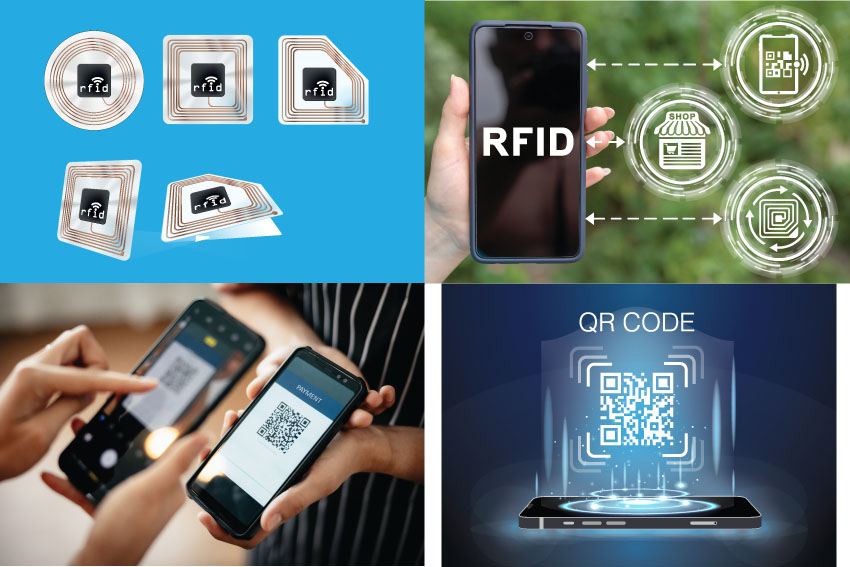
Whether you have responsibility for the management of office supplies or valuable goods, it’s likely that you’ll be aware of the various asset tagging options. However, you might well wonder about the suitability of RFID technology, QR codes and standard asset tagging technologies for your digital asset tagging purposes.
We’ll focus on the RFID vs QR code debate, considering the best use cases as well as the associated pros and cons in this blog.
What Is RFID Digital Asset Tagging?
Radio frequency identification (RFID) is a form of wireless technology that uses electromagnetic frequencies for the identification of people, animals, or objects. This method of digital asset tagging is increasingly preferred to the traditional use of barcodes.
RFID tags may either be active (with an integrated power source) or passive (with power being transmitted via the antenna). Found in passports and credit cards, the small microchips are connected with antennae for electronic scanning. The scanning range depends on such factors as the tag and reader type as well as the strength of the power source.
RFID tags are suitable for a range of purposes, including:
- Inventory control and management
- Asset and equipment tracking
- Vehicle tracking
- Security access control
A good choice for bulk scanning, RFID tags allow for highly efficient identification. The microchips can also be scanned through solid surfaces and transmit a great range of data. Being “read-write”, they can be remotely updated while in use or transit.
The biggest drawback associated with the use of RFID is the relatively high cost, with the scanners being fairly expensive. There’s the potential for interference, with a premium also having to be paid for high-capacity data storage.
What Is QR Asset Tagging?
The QR (quick response) code is a two-dimensional barcode, with a unique assortment of black squares set against a white background. As upgraded versions of more traditional barcodes, QRs can be scanned in any direction and integrated with relatively large amounts of data. Scanned using smartphones and other handheld devices, they can be linked with websites, promotions, and more.
Recommended for the storage of complex data, QR codes are commonly used for these purposes:
- Directing customers to landing pages
- Linking to downloadable apps
- Providing mapped locations and directions
- Customer ordering (e.g. via restaurant menus).
Although unsuitable for bulk scanning, individual QR codes can be read quickly and easily with smartphones. With high-capacity storage, such codes can be used for a wide variety of advertising, marketing, and packaging purposes. They can be easily generated and printed, with just 30% of the code needed for a successful scan.
RFID vs QR Code
Although versatile, QR code uses are limited when compared with RFID. Access to the linked resources depends on there being a reliable internet connection. And there’s the risk of human error, with QR codes not being scanned if they are seriously damaged, poorly printed, or displayed in low resolution.
What Are The Digital Asset Tagging Alternatives?
Other asset tracking technologies might be considered depending on the types of goods being moved, available budget, and other factors. Used across a wide range of industries and settings, one dimensional barcodes share many of the same principles as QR codes. Such affordable tags don’t require a power source and can be applied to large quantities of goods. However, as with QR codes, scanning requires line-of-sight and close proximity.
Other digital asset management tagging options include:
- NFC (Near Field Communication) - a form of contactless communication between devices allowing for such functions as secure payment and digital content transfer.
- GPS - tracking devices that transmit signals to in-orbit satellites for precise location readings.
- Bluetooth / Bluetooth low energy (BLE) - forming a wireless connection with beacon and hub devices, bluetooth technology has the benefit of relatively low energy consumption.
When it comes to RFID vs barcode vs QR code, each one has distinct pros and cons, so it makes sense to consider the suitability of asset tracking technologies on a case-by-case basis. While barcodes might be sufficient for the tracking of low-value retail items, RFID integration might be the better choice for the monitoring of expensive vehicles and factory equipment.
Track Your Assets with Label Source
No matter the asset tracking requirements, you can count on Label Source. Offering a range of asset tagging labels, and other asset management formats , we can help you keep track of everything from IT equipment to datafiles.
Go ahead and contact us for further advice and guidance on the appropriate use of asset tracking methods.